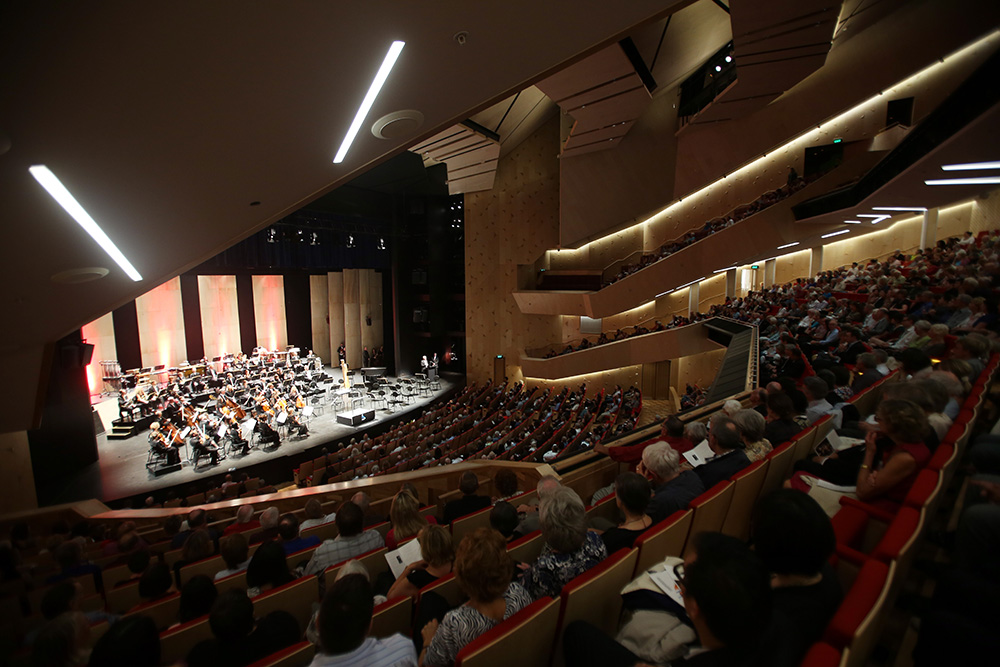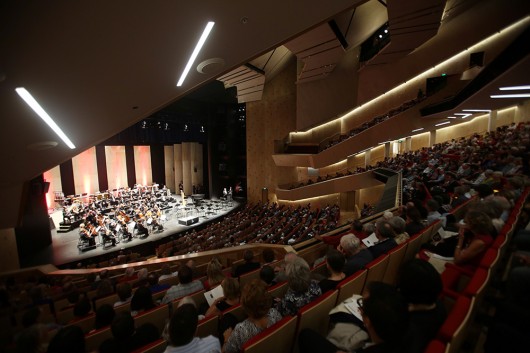STARRY NIGHTS
Using technology to transform a ‘bad’ acoustic into a beautiful and endlessly-variable one.
ASB Theatre
Aotea Centre, Auckland
www.the-edge.co.nz
Three years in development, the recently completed overhaul of Auckland’s ASB Theatre, part of the Aotea Centre, has been a long time coming.
Opened in 1990, the theatre’s original acoustic is uncompromisingly described as “bad” by Kerry Griffiths, Head of Technical Operations for The Edge, the outfit that manages Aotea Centre. And the audience area was “aesthetically pretty tired”. The theatre’s original electronically-enhanced acoustic design wasn’t popular with performers, audiences or critics; while amplified events have worked well, orchestral and operatic performances have not always been heard at their best.
Kerry notes that when the acoustic deficiencies were identified one of the possible solutions was to raise the roof — by five metres — “a very expensive option. That’s when we decided to go with Meyer Sound’s Constellation”.
MAPPING OUT CONSTELLATION
This first — and, so far, only — Australasian installation of the game-changing Constellation acoustic enhancement system has a certain poetic elegance. The theatre’s problems directly inspired Kiwi acoustic researcher Dr Mark Poletti, then a student, to develop the advanced algorithms that drive Constellation.
Already a hit in many high-profile spaces worldwide, Constellation produces a reverberant field that enhances a room’s natural sound without colouration. Audience and performers feel involved with a balanced acoustic, which reaches into under-balcony and other problem areas.
EXTRA VERSATILITY
Not only did Constellation save the expense of raising the roof, the system adds value by increasing a theatre’s versatility. It can be tailored to different uses: a drier sound for amplified performances or something warmer and reverberant for a symphony orchestra in full flight. Constellation can also provide specialised panning around a theatre, and for recreating surround sound for film performances. This instantly recallable flexibility is critical in the current market: it’s a rare venue that doesn’t need to earn its keep by hosting some mix of theatre, conferences, or amplified or orchestral music. Create a space that is acoustically neutral (not too reverberant, but not totally dead), and Constellation does the rest.
In creating a new space, there are further cost savings — and eco-friendly brownie points: the build will require less in the way of specialised building materials, and the bulky physical acoustic management normally required to change a hall’s reverberant characteristics.
HOW IT WORKS
Constellation adds reverberation to a physical space by picking up a room’s natural sound with many small microphones, feeding it through specialised hardware running software that generates natural-sounding reverberation using multiple delays, and playing it out through strategically positioned, powered speakers — mostly small but with subwoofers also placed around the room. The system is all but invisible to the audience — you have to know what you’re looking for, and you certainly can’t hear where individual speakers are located.
Ideal for a new build, Constellation can be retro-fitted, as happened with the ASB Theatre. Each new Constellation-equipped theatre is a custom installation, with the Meyer Sound team ensuring the best placement of mics and speakers and helping to finesse the final acoustic result. The team’s experience is particularly welcome when enhancing a heritage theatre which can’t be drastically altered.
ORCHESTRATING THE DIFFERENCE
Refurbishing the ASB Theatre wasn’t all about installing Constellation: the room now has a lot of visible timber, with side and overhead reflector panels and parquet flooring. As Kerry Griffith says, “We didn’t really have to factor a lot in for the Constellation. The majority of the improvements and the designs were around the room’s natural acoustic, with the view that Constellation would give us the variable aspect.”
The venue team is pleased with the results: “The best feedback we’ve had is that it feels like a whole new room. One remarkable change has come from the orchestra pit, which we didn’t expect. But the first time the orchestra played in the pit for an opera, I suspect everybody thought it was a completely different orchestra because it just sounded so different!”
The theatre was officially re-opened in April 2013, but fine-tuning, courtesy of Meyer Sound technicians, has only recently been completed. Those last tweaks ensured the on-stage sound was comfortable for orchestral musicians.
Audience reaction has been overwhelmingly positive, with even a nearly empty theatre feeling warm, alive and controlled. Kerry concurs: “It feels more intimate than it used to, which is kind of surprising. We expected it to have the opposite effect, but you feel more connected with the stage.”
CONTACTS
Bartons Sound Systems: www.bartonsound.co.nz
Marshal Day Acoustics (Acoustic Consultant): www.marshallday.com
Schuler Shook (Theatre Consultant): 0438 382 408 or
www.schulershook.com
archoffice (Design): www.archoffice.co.nz
Steensen Varming (Lighting Design): (02) 9967 2200 or
www.steensenvarming.com


